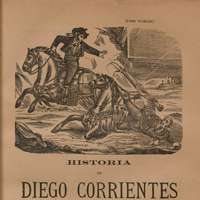Read all about it!

A new study of wrongdoing and its cultures in Spain 1800-1936 will explore the fascination of popular versions of crime and other misdemeanours in ways that reflect also on our attitudes to crime in our time.
The flip side of contemporary fear of crime is our fascination with it. Repelled we might be, but the popularity of watching CCTV footage of real crimes or reading the latest salacious scandals in tabloids is testament to modern society's appetite for stories that shock.
This fascination with crime is not new; nor is the popularity of the materials that purvey it. Cambridge researcher Professor Alison Sinclair has set out to discover what Spain thought about wrongdoing between 1800 and 1936 by examining a wide range of sources, and in particular the equivalent of the mini-tabloids of the time - so-called chapbooks or pliegos sueltos - of which an extensive archive exists in Cambridge University Library.
Sold on street corners by hawkers and luridly illustrated, the sueltos carried vivid tales of the unlawful, the improper and the morally corrupt.
"Spain in the 19th century was chaotic and troubled. It has no literary work that is the equivalent of Dostoievsky's Crime and Punishment, and yet the figures for violent crime in the 19th century in Europe place Spain as one of the highest countries on the list," explained Professor Sinclair, whose three-year research project has been funded by the Arts and Humanities Research Council. "With their mix of fact and fantasy, the sueltos provide a window not only into wrongdoing at the time but also into its representation and the way people perceived it," thus complementing in a completely original way other literary and cultural representations of wrongdoing.
The sueltos spoke to an audience entranced by the exploits of such characters as Francisquillo the Tailor, a boastful chap whose scissors turn out to be his major weapon in a series of dramatic stand-offs about honour. A recurring (and real) character is Diego Corrientes, born in Seville in 1757, a Spanish Robin Hood figure who took from the rich and gave to the poor, and who died by hanging aged 24 years.
The archive also includes the tale of Rosaura, whose suitor persuades her into elopement, only to rape her, in company with his cousin, and leave her bound to a tree, where she is found by a passing huntsman. The University Library has at least six different versions of this story, with clearly varied takes on how to depict Rosaura's state of undress.
A key feature of the project will be to catalogue and digitise 4,470 sueltos held in the University Library and the British Library. Many are in an exceptionally fragile state and a goal of the project is to create a world-class and accessible collection, to be held in the University's central repository DSpace@Cambridge (www.dspace.cam.ac.uk/).
Clearly related to a specific time and place, the project raises questions relevant for modern society. As Professor Sinclair comments: "The research will help us to question, as cultural consumers, our excited and emotional responses to this sort of material, including processes of identification and voyeurism."
Provided by University of Cambridge
















